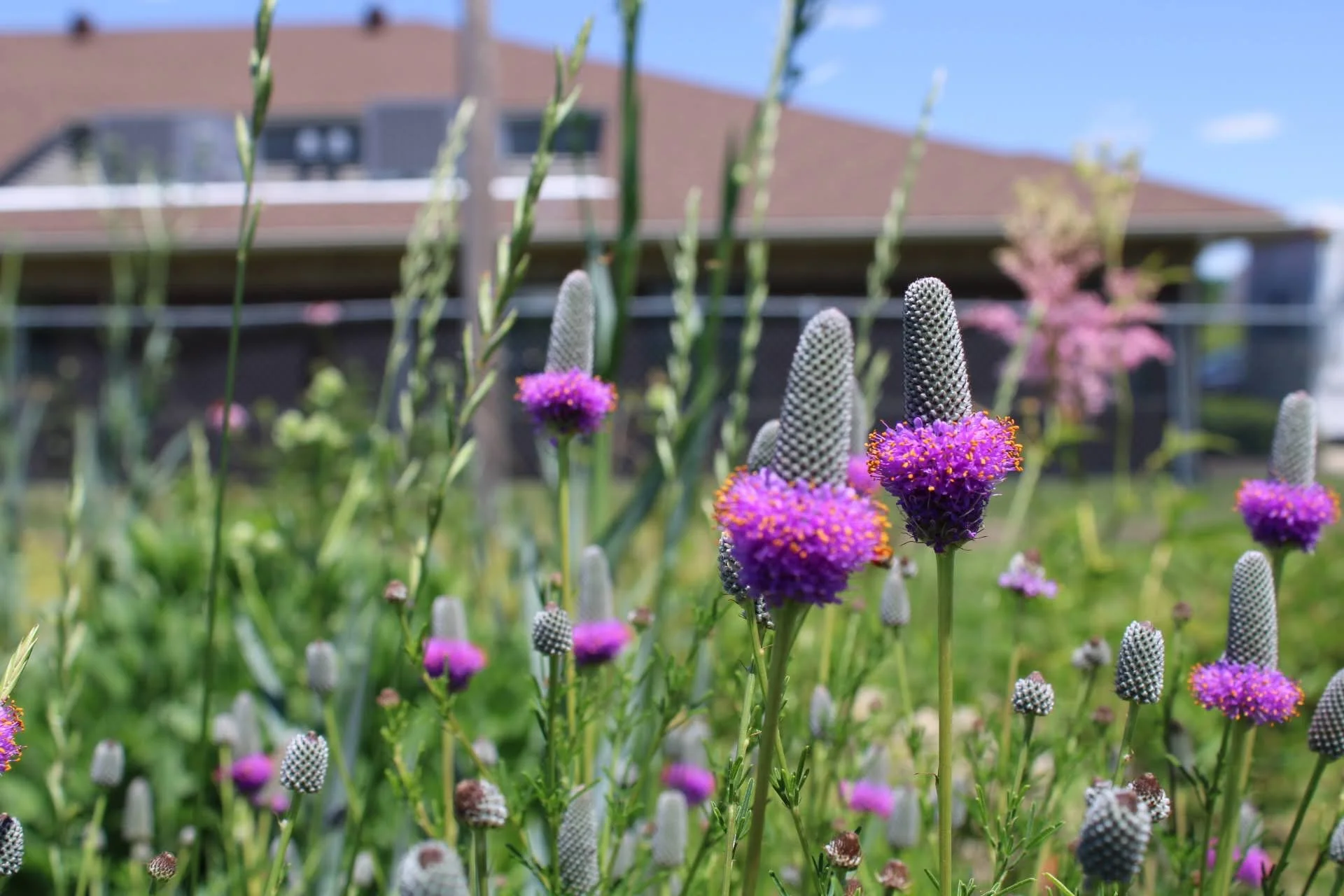Welcome to Purdue Extension of Johnson County!
You might be thinking what do native plants have to do with stormdrains? Actually a lot! Rain gardens are key to improving water quality in our local creeks, streams, & rivers!
What’s Up with Rain Gardens?
Rain gardens are often used to collect runoff from roofs, driveways, lawns, or streets. You know all those impervious surfaces that us humans love. About 70% of water pollution is a result of stomwater (oof, not great). To help prevent some of that pollution, rain gardens act like mini urban wetlands that help prevent flooding and slow down stormwater before it goes down the storm drain and out into our local waterways.
Native plants have ridiculously deep roots that are the key to a successful rain garden. Some native plant roots grow deeper than they are tall and for a plant like Compass Plant that grow up to 8 feet tall that seems impossible but real cool
These deep roots act like Brita filters for stormwater. They are awesome at absorbing and soaking up nutrients and pollution from runoff from farms and lawns cause, you know, fertilizer
Sediment aka soil aka good old dirt is the number one pollutant of our streams and waterways due to erosion from farms, construction, and other bare soil situations that we didn’t list. Rain gardens can help filter out the soil by slowing down the runoff after typical, unpredictable rain events
These roots also help the rain garden act like a sponge so they can absorb excess water to prevent flooding. Instead of the instant gratification of being directly released into a water way through a stormdrain, rain gardens often make the stormwater wait a day before being filtered into waterways
What You Can Do…
Install A Rain Garden
If you have an area of your yard that has standing water or a depression in the landscape, consider installing a rain garden for all of the reasons listed above and cause you know it will be less to mow…
Rain garden species to consider are Queen of the Prairie, New England Aster, Swamp Milkweed, Blue Flag Iris, Cardinal Flower…we could go on forever
Update that Retention Pond Shoreline
Don’t have an area for a rain garden but your neighborhood has a retention pond? Add native plants to the shoreline to help filter out pollution and keep those pesky Canada Geese away. They don’t love being in an area with tall plants cause they could fall victim to a sneak attack by a predator
Scroll through the gallery below to see Purdue Extension plants in bloom!
Click on the photos & USDA Fact Sheet links to learn more about the plant species
Need Identification Help? Want to Show Us What is Blooming?
Native Seeds in the Library
Both Swamp Milkweed & Rattlesnake Master are guaranteed to attract native bumblebees, butterflies, and other pollinators! Click on the images & USDA Fact Sheet links to learn more about these summer blooming species to see if they can find a home on your own property!
Purdue Extension of Johnson County Rain Garden
The site was previously a grassy area beside a building and a parking lot. The rain garden is located at the Extension office in Franklin, Indiana. It is visible to the public, but it cannot be seen from the front of the building. The 300 square foot rain garden was installed in September 2019 by participants of a 2-day rainscaping workshop. This site was chosen because it receives runoff from a nearby roof and there are many plants in other areas around the office. Obstacles of the installation included the expenses and the excavation of the site, however each were eventually handled successfully. The rain garden has an ecological impact, as it filters runoff storm water from a downspout. The rain garden also creates a conversation piece.
This rain garden is home to 236 native plants of twelve different species. All plants were acquired from Spence Nursery, and planted with 12 inch spacing. The garden is weeded by hand every 4 weeks or as needed by EMG volunteers and extension staff. Herbicide was used around the perimeter to keep grass back. No fertilizer was added and the native plants have adapted to the soil type on the site. Sand and compost was added when the initial excavation took place.
Purdue Extension is your educational partner for life. Extension delivers practical, research-based information and events for Indiana’s residents in agriculture and natural resources, health and human sciences, and community development, and trains tomorrow's leaders through Indiana 4-H Youth Development.
In Johnson County, the Extension staff assists community members with educational programs regarding yard/garden, wildlife, farmland economics, diversified farming, livestock, nutrition, wellness, child development, family finance, 4-H, and more. To contact us with questions, please call 317-736-3724 or email Sarah Hanson sspeedy@purdue.edu
A big thank you to Nicole Marshall from Waypoints Designs for doing the artwork throughout the Little Native Seed Library Trail! Click on the Button below to learn more about them!





















